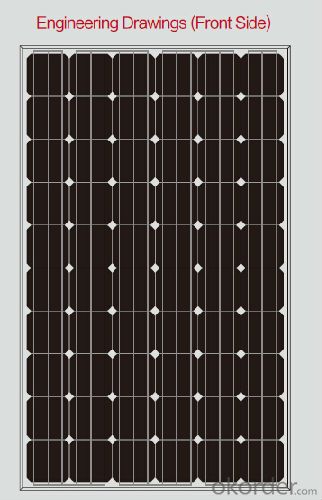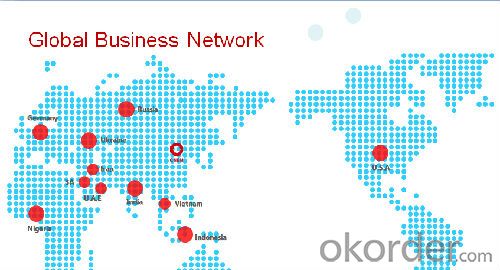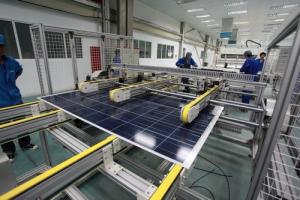Mono 230W Solar Panel Made In China and Low price
- Loading Port:
- Shanghai
- Payment Terms:
- TT or LC
- Min Order Qty:
- 1 PCS
- Supply Capability:
- 100000 PCS/month
OKorder Service Pledge
OKorder Financial Service
You Might Also Like
Advantage:
1.Widely using of the most popular and mature type of modulesfor on-grid system.
2.Specifications subject to technology and test conditions,GSUN Solar reserves the right of final interpretation.
3.Leading manufacturing technology in PV industry, strictly controlling the quality of raw materials and the process of producing.
4.100% EL inspection, ensures modules are defects free.
5.Cells binned by current to improve module performance.
6.Anti reflective glass. Not only to increase the light absorption, but also to make the module has the function of self-cleaning in water environment, effectively reducing the power loss caused by dust.
7.Outstanding performance in low-light irradiance environments.
8.Excellent mechanical load resistance: Certified to withstand high wind loads(2400pa) and snow loads(5400pa).
9.High salt and ammonia resistance.
10.Positive power tolerance:0-+5w.
Specification:
Temperature Coefficient
NOCT | 45℃±2℃ |
Temperature Coefficients of Isc (%/℃) | 0.0492 |
Temperature Coefficients of Voc (%/℃) | –0.3374 |
Temperature Coefficients of Pmp (%/℃) | –0.4677 |
Performance Parameters
Max Power Voltage Vmp(V) | 30.3 | 30.8 | 31.1 | 31.4 | 31.9 |
Max Power Current Imp(A) | 7.60 | 7.64 | 7.73 | 7.81 | 7.85 |
Open Circuit Voltage Voc(V) | 36.1 | 36.6 | 37 | 37.3 | 37.7 |
Short Circuit Current Isc(A) | 8.50 | 8.55 | 8.65 | 8.75 | 8.85 |
Max Power Pm(W) | 230 | 235 | 240 | 245 | 250 |
Mechanical Data
Dimension | 1655 x 992 x 40 mm |
Weight | 22.5kg |
No. of Cells and Connections | 60 (6 x 10) |
Tolerance | 0~+5W |
Cell | Monocrystalline Cell 156 x 156 mm |
Packing | 624 Pcs/40ft(H) Container |


Warranty
5 years product warranty
10-years 90% of Min. rated output power,and 25-years 80% of Min. rated output power warranty
Comprehensive Certificates:
CE Certificate
ISO 9001:2008:Quality management systems
IEC61215、IEC61730
TUV and UL
IDCOL for Bangladesh
Feature:
- High efficiency, multicrystalline silicon solar cells with high transmission
and textured glass deliver a module effi ciency of up to 16.0%,
minimizing installation costs and maximizing the kWh output of your
system per unit area.
- Tight positive power tolerance of 0W to +5W ensures you receive
modules at or above nameplate power and contributes to minimizing
module mismatch losses leading to improved system yield.
- Top ranking in the “TÜV Rheinland Energy Yield Test”
FAQ:WHAT'S THE ADVANTAGES OF CNBM?
1.CNBM is a state-owned company under jurisdiction of central goverment , one of Fortune 500 .Just because of this ,we can get more support and resources from our government.So ,it is realiable .
2.CNBM's solar products are high-qualified with TUV,UL,VDE,CE,ISO certificates. Our products ranges top in China.
3.Just as I mentioned in attahment ,we signed 500MW project with Urkan under the witness of our chairman Xi Jinping ,CNBM has ability to meet your large quantity needs,Our annual capacity is 1GW.
4.We can offer you a competitive price .Because you are our potential and valued customer .
5.We ,CNBM ,has our own factory :CNBM JETION SOLAR .We can also customize according to customers' need . You can google our factory .
FAQ:Why install a Solar PV system?
There are many reasons to install a Solar PV system now:
As a low risk investment the returns of between 8-10% net are hard to beat especially during this financial downturn where bank interest rates are below inflation (i.e. money in a savings account even with interest added is actually reducing in value).
Its good for the environment. Installing a small domestic system of around 1.5 kW would provide around 1125 kWh of electricity every year, this would save around half a tonne of CO2 annually.
Electricity can be supplied at the point of use. Reducing strain on our national grid network.
The system will run silently and so will cause minimal disruption.
There is very little maintenance required for a PV system.
After the initial installation costs, there are no further fuel costs.
PV systems are modular, and can be added to at any time.
FAQ:How long will a Solar PV system last?
The MCS accreditation scheme means that all panels installed under the scheme by approved agents will continue to generate for at least 25 years. Over this time their output will diminish slightly but they should still perform at 85% at the 25 year mark according to the scheme rules. Manufacturers have invested heavily to ensure their products meet and in most cases exceed these target
- Q:I just bought a quot;00 wattsolar panel system to install on my house. I just wanted to know if by 00 watts, does that mean per hour, min, day week or what?
- 00 watts is like energy consumption. The computer i am using right now is probably around 300 watts right now. It's not always 00 watts, that's probably maximum. And also, watts = volts x amps.
- Q:I jotted down some notes for my Technology and Architecture class and I'm trying to figure out what i meant when i said 'Treated with gases at extremely high temperatures.' I have NO idea what I was talking about :) Im trying to figure out if what I am talking about is about Silicon, Polychristaline, or a Solar Cell/Panel.
- Let me help you get an idea of what you are talking about as your notes seems a bit jumbled. Mostly when they refer to a silicon solar cell they mean that the silicon is one crystal of silicon. (very much like a diamond, but with atoms of silicon instead of carbon). A single perfect crystal of silicon can be grown that is very large at temperatures near the melting point of silicon or around 400C and then is sawed up to create electronics or solor cells. Polycrystalline :) solar cells are also made of silicon, but instead of a single crystal it is made of a jumble of small crystals that have different sizes and directions. So these types of solar cells can be made using a silicon gas (siline: SiH4) at much lower temperatures 600-700C. So these are less expensive to make, but because they are not perfect crystals a poly solar panel that is the same size as a crystalline solar panel will make less energy. I hope that helps.
- Q:I need to know how Solar panels work please help me!! Also, if you know any other additional important information about Solar Energy in General please tell me, Thanks.
- The most important parts of a solar cell are the semiconductor layers, this is where the electron current is created. There are a number of different materials available for making these semiconducting layers, and each has benefits and drawbacks. Unfortunately, there is no one ideal material for all types of cells and applications. In addition to the semiconducting materials, solar cells consist of a top metallic grid or other electrical contact to collect electrons from the semiconductor and transfer them to the external load, and a back contact layer to complete the electrical circuit. Then, on top of the complete cell is typically a glass cover or other type of transparent encapsulant to seal the cell and keep weather out, and a antireflective coating to keep the cell from reflecting the light back away from the cell. A typical solar cell consists of a cover glass, a anti-reflective layer, a front contact to allow the electrons to enter a circuit and a back contact to allow them to complete the circuit, and the semiconductor layers where the electrons begin to complete there voyages! The solar panels, in order to generate power, are using the method of screen-printing, a technique developed for printing fabrics, paper and to produce plastic, glass and metal solar cells. The basic materials of a photovoltaic cell (solar cell) are inexpensive. The homemade solar cells have about /4 of the efficiency of commercial silicon solar cells, which turn 0-20 per cent of light energy into electricity. But, being cheap to produce, they can make up the loss in quantity what they lack in quality.
- Q:Can solar panels be installed on airports?
- Yes, solar panels can be installed on airports. In fact, many airports around the world have already adopted solar power systems to generate clean and renewable energy. These panels can be installed on rooftops, parking lots, or open spaces within the airport premises, effectively reducing their reliance on traditional energy sources and contributing to a more sustainable aviation industry.
- Q:Can solar panels be used in areas with high levels of UV radiation?
- Yes, solar panels can be used in areas with high levels of UV radiation. In fact, they are designed to withstand and harness UV rays from the sun to generate electricity. The materials used in solar panels are specifically chosen to endure high UV exposure, ensuring their efficiency and longevity even in such conditions.
- Q:Can cold light make solar panels power
- light - heat - dynamic - electric conversion method through the use of solar radiation generated by thermal power, usually by the solar collector will absorb the heat energy into the refrigerant, and then drive the turbine power generation. The latter process is the light-heat transfer process; the latter process is the heat-to-conversion process, which is the same as the conventional thermal power generation.
- Q:planning to get one, for a store/house, we use alot of electricity at least 500-3000 dollars a month. how much money would this save us? how big would we have to get the solar panel?[aproximately]
- In the US, the average electric cost $.5/kw-hr. $2500 means you are using 6700 Kw-hr/month or 550 kw-hr/day. Since solar panel only make peak kw for about 5 hours per day (in sunny places like (AZ) you will need a 0 kw system. Solar systems cost about $7/watt so your system will cost about $750,000. The government my pay for about $250,000, so be prepared to spend one half a million dollars. You will also spend about $250/month on maintenance of the system. The system will lose about %/year of it's efficiency, so the system will be paid for in 240 months, or 20 years. With in 5 years after the system is paid for, they will have to be replaced, the cost will be another 2 million dollars.
- Q:Can solar panels be installed on a south-facing wall?
- Yes, solar panels can be installed on a south-facing wall. In fact, a south-facing wall is often the most ideal location for solar panel installation as it receives the most sunlight throughout the day.
- Q:Can solar panels be installed on schools or educational institutions?
- Yes, solar panels can be installed on schools or educational institutions. In fact, many schools have already adopted solar energy as a sustainable and cost-effective solution. Installing solar panels on educational institutions not only reduces their carbon footprint but also provides valuable educational opportunities for students to learn about renewable energy.
- Q:Can solar panels be installed on military bases or installations?
- Yes, solar panels can be installed on military bases or installations. In fact, many military bases around the world have already adopted solar energy as a means of reducing their reliance on traditional fossil fuels and increasing their energy security. Solar panels provide a sustainable and cost-effective source of electricity, which aligns with the military's efforts to improve environmental sustainability and operational efficiency. Additionally, solar installations on military bases can enhance energy resilience and readiness by reducing vulnerability to power outages and disruptions.
1. Manufacturer Overview |
|
|---|---|
| Location | |
| Year Established | |
| Annual Output Value | |
| Main Markets | |
| Company Certifications | |
2. Manufacturer Certificates |
|
|---|---|
| a) Certification Name | |
| Range | |
| Reference | |
| Validity Period | |
3. Manufacturer Capability |
|
|---|---|
| a)Trade Capacity | |
| Nearest Port | |
| Export Percentage | |
| No.of Employees in Trade Department | |
| Language Spoken: | |
| b)Factory Information | |
| Factory Size: | |
| No. of Production Lines | |
| Contract Manufacturing | |
| Product Price Range | |
Send your message to us
Mono 230W Solar Panel Made In China and Low price
- Loading Port:
- Shanghai
- Payment Terms:
- TT or LC
- Min Order Qty:
- 1 PCS
- Supply Capability:
- 100000 PCS/month
OKorder Service Pledge
OKorder Financial Service
Similar products
New products
Hot products
Hot Searches
Related keywords































